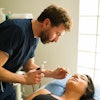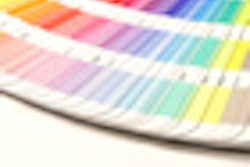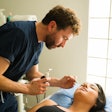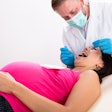
When it comes to achieving the best results for patients who are unable to get to a custom shade lab for an appointment, digital photography is an invaluable tool. However, even with all the advantages brought by this technology, variables still remain. In this Second Opinion, Mike Dominguez, CDT/TE, looks at how to maximize the quality of your digital images to obtain the best custom shade.
Even with advancements in digital technology, a dental technologist is simply unable to predictably determine the correct shade based on photos alone. To resolve crucial cases to everyone's satisfaction, it is better for the patient to visit the lab for custom shade matching.
 Mike Dominguez, CDT/TE.
Mike Dominguez, CDT/TE.
Before this custom shade lab appointment, however, the patient should be asked if they are bleaching or plan on bleaching. If the answer is yes, then shade records should be taken one week after the last bleaching treatment to allow tooth structures to rehydrate and the new shade to stabilize.
It is also important to manage the patient's expectations regarding the final result. This discussion will include understanding restorative products' characteristics and best uses, costs, and time commitment for treatment. It is also important to understand the "pickiness" of the patient. For example, if the patient is "picky," it would be best to select restorative materials after the shade has been selected, and then reset expectations.
If the patient is unable to visit the lab for a custom shade, the shade must then be selected in-office and prescribed. The selected shade tab(s) should be in the photos to assist in characterizing the restoration. Photography should include before and stump photos of hydrated teeth.
With shade tabs in the photos, the ceramist will more easily extrapolate the subtleties of the target tooth in the language of their porcelain system and more easily approximate the desired shading. It is always best to also include shade tabs with the case, if possible. Most dental labs use specific porcelain formulas or recipes for the Vita Classical or 3D-Master shade guides.
Cameras
Your camera is as important as the information you are trying to capture. The camera you choose does not have to be the most expensive or complicated. It just needs to take properly framed intraoral pictures with a zoom lens at high resolution, with its own source of light.
“It is also important to manage the patient's expectations regarding the final result.”
While a digital single-lens reflex (DSLR) camera is the gold standard, within the past five years, point-and-shoot (PNS) camera kits from Photo Med and Dental Learning Centers also have proved to be effective and easy-to-use tools.
Unfortunately, a camera on a smartphone is still not a viable tool for intraoral photography, as they are exceedingly susceptible to environmental light. If using a smartphone camera is the only option, however, Smile Line's Smile Capture kit for the iPhone has enjoyed positive reviews.
For proper lighting, use a point flash (left and right strobe flashes) for anterior photography and a ring flash for posterior photography.
Whichever camera setup you use, important information must be captured in high resolution. For best results, fill the frame of the picture with the target tooth and shade tab without need for cropping. DSLRs such as from Canon and Nikon are available with excellent 100- and 105-mm macro lenses, respectively. Photo Med and Dental Learning Centers have special macro lenses for PNS cameras with preprogrammed settings. Smile Line's setup comes with a special light and app that provides guidance. My preference is the Canon D series (50 or above) with the twin flash or split ring and 100-mm macro lens.
Camera angle and recording shade tabs
Every camera has a histogram display. This is a bell curve indicating the kind and quality of information collected. If the bell curve is too far to the right (overexposed), the information will appear washed-out. Too far to the left (underexposed), the information was not recorded. A bell curve in the middle is most desirable.
When taking a picture, the shade tabs should be positioned below the maxillary teeth or above the mandibular teeth, while maintaining a slight gap between tab and target tooth. Pictures with more than one shade tab are helpful, but only after isolating a single prescribed shade tab. Always send a photo with only the prescribed shade tab approximating the target tooth. If multiple shades are prescribed, send pictures with each tab, by itself, incisal edge-to-edge, to the target tooth.
 Three different shade tabs capturing different shade zones with proper camera angle, and using a point flash to avoid and minimize glare. All images courtesy of Mike Dominguez, CDT/TE.
Three different shade tabs capturing different shade zones with proper camera angle, and using a point flash to avoid and minimize glare. All images courtesy of Mike Dominguez, CDT/TE.
For maxillary teeth, the camera lens should be positioned above the target tooth looking downward on the targeted tooth. The shade tab should be held in the same plane as the tooth to reduce unwanted glare to no more than the gingival area. Unwanted glare in the middle of the tooth or on the shade tab will overexpose those areas and cause the information to be lost. Additionally, the suggested camera position will better highlight incisal characteristics.
For mandibular teeth, the lens should be positioned perpendicular to the facial plane to take advantage of the natural labial inclination of the teeth. However, protruded teeth may require a change in camera angle to reduce glare.
Along with the shade tab photos, full-frame photos of the target tooth help the ceramist reproduce important aesthetic characteristics. Of course, pre-op full-face photographs, followed by full-face photos with temps, are always important to help the ceramist have proper perspective.
Mike Dominguez, CDT/TE, founded Kymata Dental Arts in Seattle in 2009 and is a charter member of OPT-In Dental Laboratory Cooperative, where this article ran originally in a different form (for reprints, please see their website). Dominguez is president of the Washington State Dental Laboratory Association. He also sits on the Editorial Advisory Board for the peer-reviewed journal Inside Dental Technology, and is a national lecturer on laboratory materials and techniques.
The comments and observations expressed herein do not necessarily reflect the opinions of DrBicuspid.com, nor should they be construed as an endorsement or admonishment of any particular idea, vendor, or organization.



















